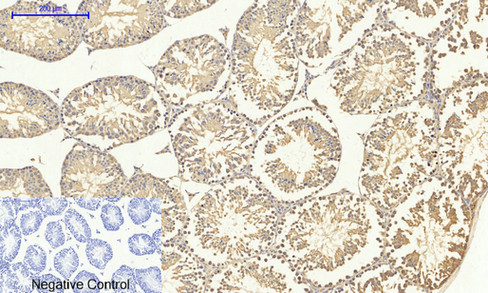SMAD4 Polyclonal Antibody
For reference only. Please follow the manual included in your kit for instructions.
Catalog Number
RD72661A
Product Name
SMAD4 Polyclonal Antibody
Catalog Number
RD72661A
Clonality
Polyclonal
Purification Method
Affinity purification
Isotype
IgG
Host
Rabbit
Background
This gene encodes a member of the Smad family of signal transduction proteins. Smad proteins are phosphorylated and activated by transmembrane serine-threonine receptor kinases in response to TGF-beta signaling. The product of this gene forms homomeric complexes and heteromeric complexes with other activated Smad proteins, which then accumulate in the nucleus and regulate the transcription of target genes. This protein binds to DNA and recognizes an 8-bp palindromic sequence (GTCTAGAC) called the Smad-binding element (SBE). The Smad proteins are subject to complex regulation by post-translational modifications. Mutations or deletions in this gene have been shown to result in pancreatic cancer, juvenile polyposis syndrome, and hereditary hemorrhagic telangiectasia syndrome.
SMAD4 (SMAD Family Member 4) is a Protein Coding gene. Diseases associated with SMAD4 include Myhre Syndrome and Polyposis, Juvenile Intestinal. Among its related pathways are PEDF Induced Signaling and Validated targets of C-MYC transcriptional repression. GO annotations related to this gene include transcription factor activity, sequence-specific DNA binding and sequence-specific DNA binding. An important paralog of this gene is SMAD9.
Immunogen Information
Immunogen
Synthesized peptide derived from the N-terminal region of human Smad4
Swissprot
Q13485
Synonyms
(Small) Mothers Against DecapentaplegicDeleted in Pancreatic Carcinoma 4Deleted in Pancreatic CarcinomaDeleted in pancreatic carcinoma locus 4Deletion target in pancreatic carcinoma 4DPC 4DPC4hSMAD4JIPMAD homolog 4MAD mothers against decapentapl
Calculated MW
60 kDa
Observed MW
60 kDa
Applications
Reactivity
Human,Mouse,Rat,Monkey
Tested Applications
IHC-p,IF,ELISA
Conjugation
Unconjugated
Dilution
IHC 1:100-1:300, IF 1:200-1:1000, ELISA 1:10000
Concentration
1 mg/mL
Storage Buffer
PBS with 0.02% sodium azide, 0.5% protective protein and 50% glycerol, pH7.4
Storage Instructions
Store at -20°C. Avoid freeze / thaw cycles.

